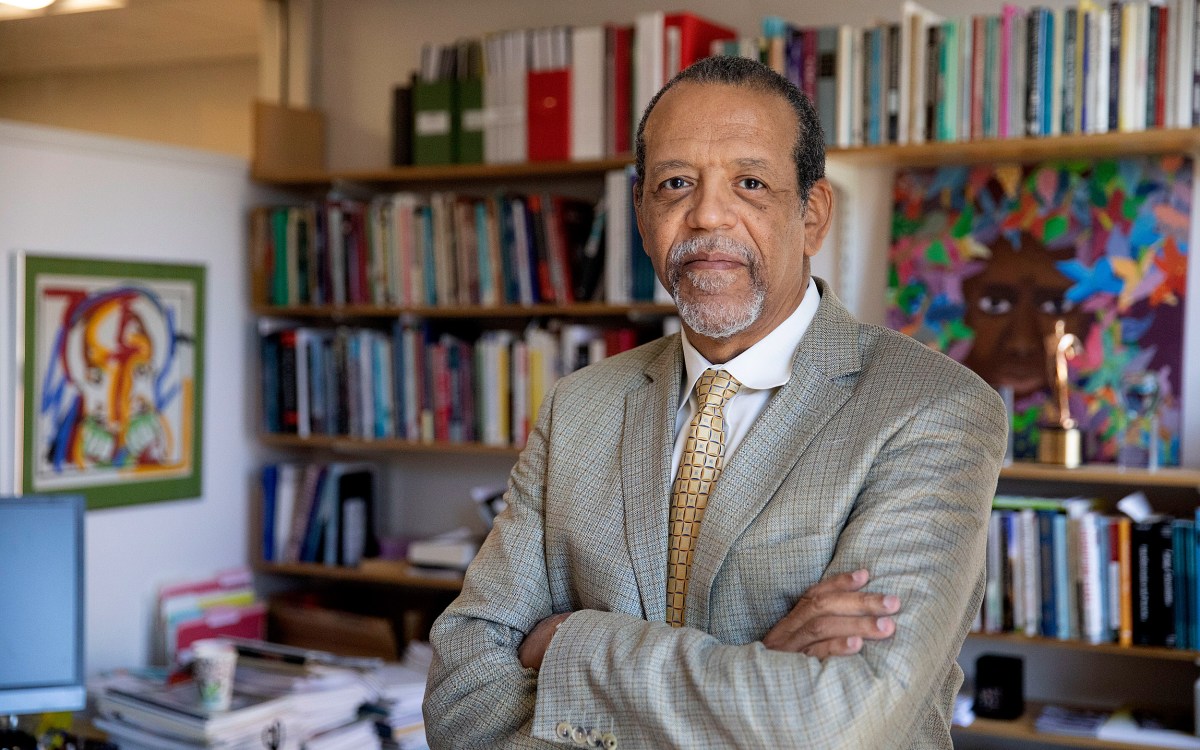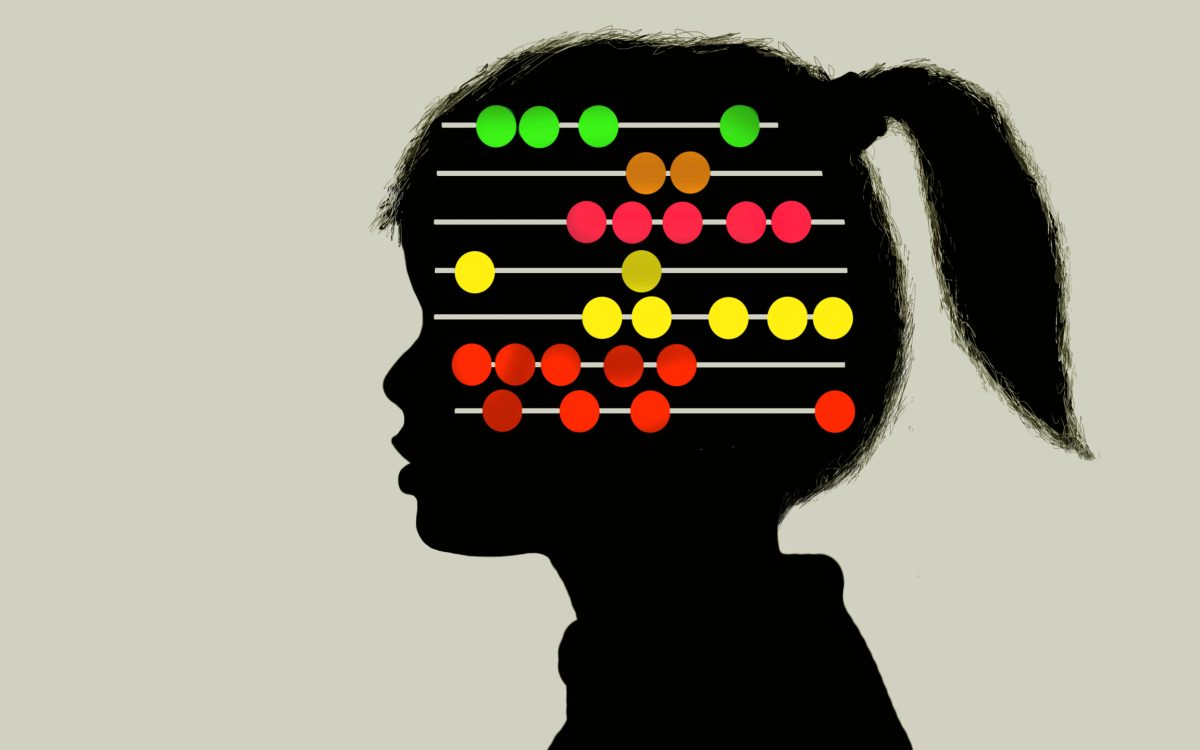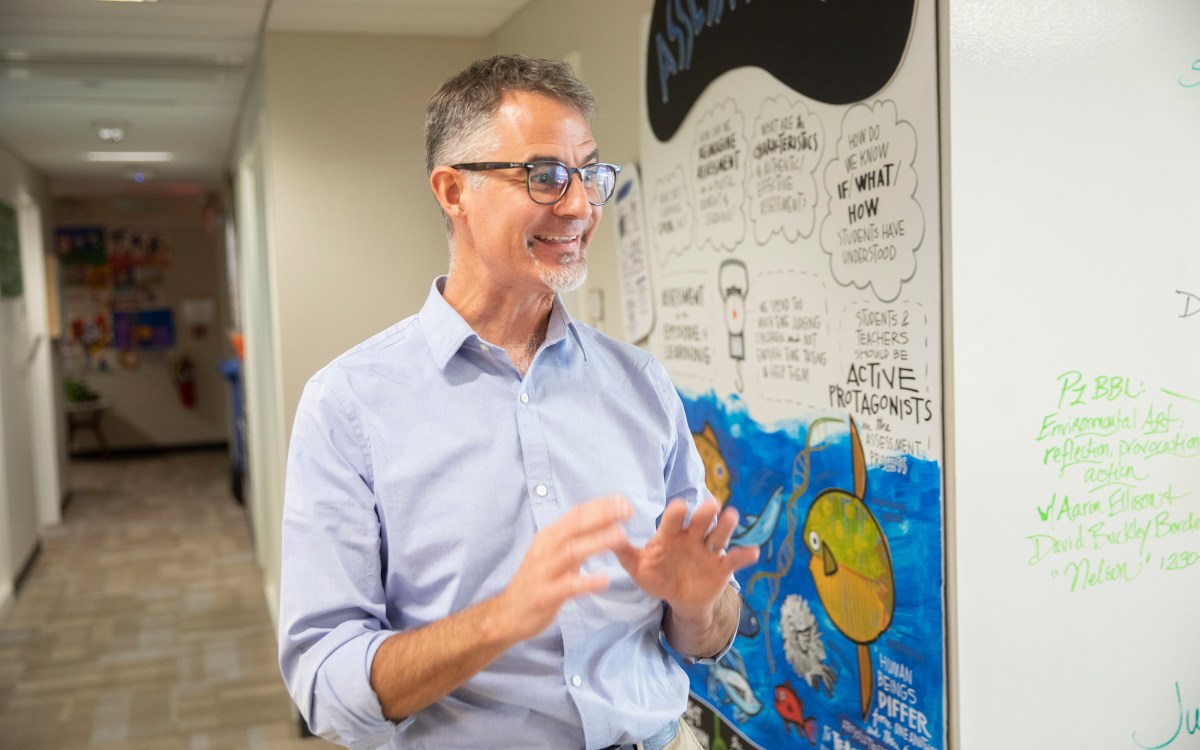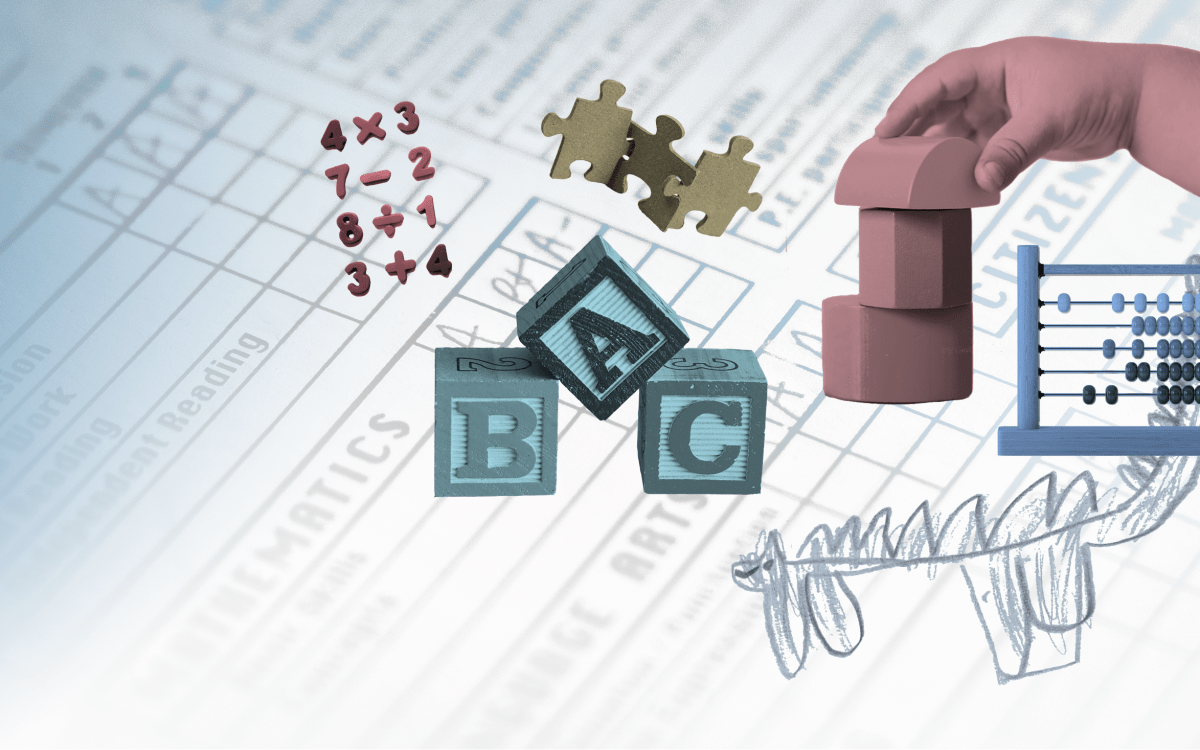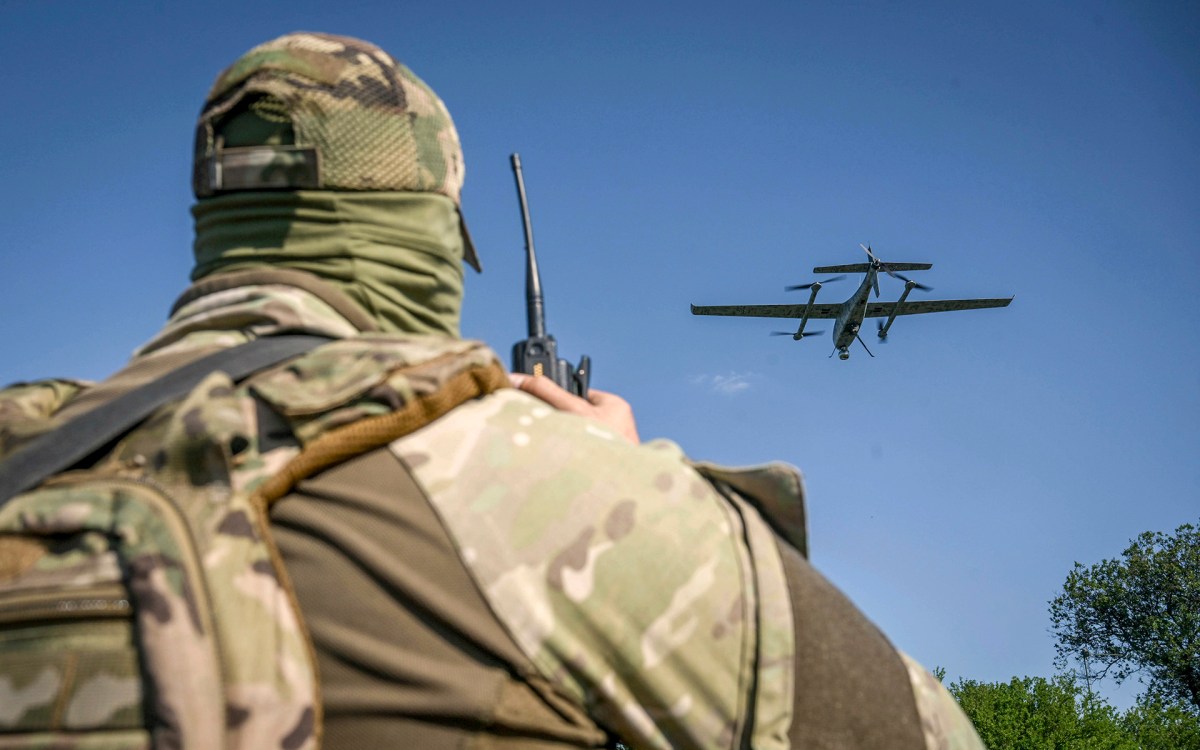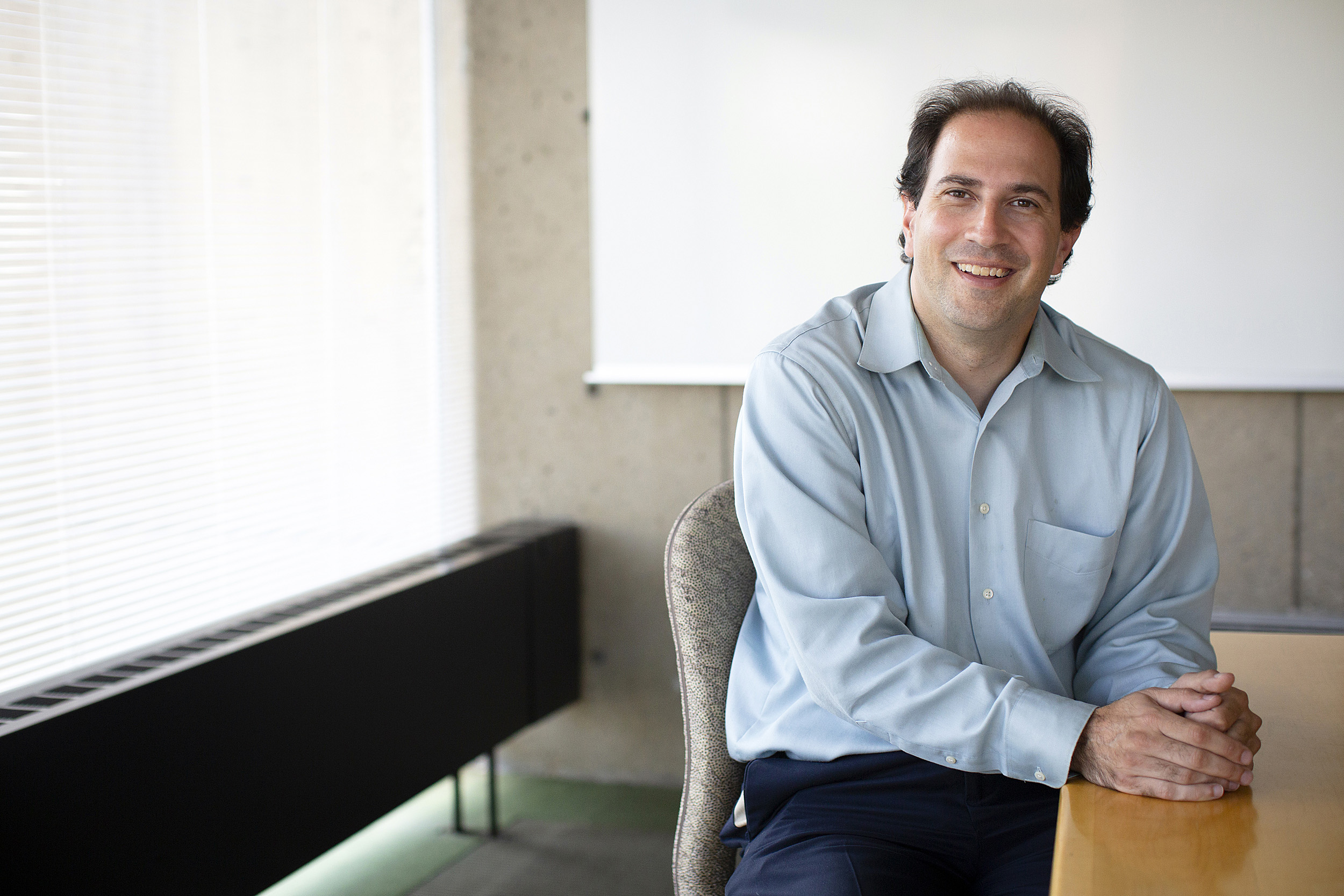
Jal Mehta and “In Search of Deeper Learning” co-author Sarah Fine visited dozens of high schools across the country.
Stephanie Mitchell/Harvard Staff Photographer
Searching for deeper learning
A recipe for how high schools can foster more analytical, critical, and creative thinking
Jal Mehta, professor of education at the Graduate School of Education (GSE), and Sarah Fine, Ed.M. ’13, Ed.D. ’17, visited 30 innovative public high schools across the country to examine where students were experiencing what the two call deeper learning. What they found was surprising: Even in the most celebrated schools, the learning that allows students to grow as thinkers and critical and creative learners is more often the exception than the rule. The Gazette sat down with Mehta to talk about the book he recently published with Fine, “In Search of Deeper Learning,” the role of teachers in leading students to deeper learning, and what it takes to remake the American high school.
Q&A
Jal Mehta
GAZETTE: You and your co-author visited successful high schools in search of deeper learning experiences. Can you tell us what you found?
MEHTA: There’s good news and bad news. The bad news was that in these schools, which had been recommended as places that did 21st-century learning or particularly rigorous forms of traditional learning, students still experienced a lot of unchallenging instruction; they were doing a lot of worksheets and tasks that were pretty low level, where they were expected to memorize content and apply algorithms rather than analyze, synthesize, and create. That was pretty disappointing because these schools were seen as places that were trying to break that mold. The good news was that there were spaces within almost every school where powerful learning was happening. In almost every school we visited, including lots of traditional public schools, there were bright spots: really compelling teachers and elective classes and extracurricular activities where students were engaged and were learning by doing.
GAZETTE: How do you describe deeper learning?
MEHTA: Deeper learning is the understanding of not just the surface features of a subject or discipline, but the underlying structures or ideas. If we were talking about a biological cell, shallow learning would be able to name the parts of the cell; deeper learning would be able to understand the functions of the cell and how they interrelate.
When you listen to the show “Car Talk,” you are listening in on a conversation between someone who has a shallow understanding of their car and someone who has a deeper understanding. A person will call in and say, “My car tends to slow down when it rains.” And then one of the guys will say, “Well, does it happen more in hot weather or cold weather?” The caller can only see the symptoms; the person at the other end of the phone can see the system and has some underlying theory or diagnosis of what might be happening.
We also say in our book that deeper learning tends to emerge at the intersection of mastery, identity, and creativity. Mastery is developing significant knowledge and skill; identity is seeing yourself as connected to doing the work; and creativity is not just taking in knowledge but doing something in the field. When those three elements come together, it often yields deep learning.
GAZETTE: Your book says deeper learning happens more in electives and extracurriculars than in core classes. Why is that?
MEHTA: When we visited schools, we asked students, teachers, and administrators to point us to the most powerful learning spaces in their schools. They frequently pointed to elective classes and extracurricular spaces. The reason for that is that electives offer more opportunity to go into more depth. For example, a teacher might be teaching a ninth-grade history class, which goes from ancient Mesopotamia to the French Revolution at a breakneck pace, and then maybe in the afternoon, he’s teaching an elective on the Cold War, where they’re looking at film, literature, history, and so on. And obviously, one of the characteristics of electives is that they are elected so both students and teachers choose to be there; choice is clearly part of the story.
“When we visited schools, we asked students, teachers, and administrators to point us to the most powerful learning spaces in their schools. They frequently pointed to elective classes and extracurricular spaces.”
As for the extracurriculars, we did a deep dive on theater and debate, and those were really different domains, but they shared a number of elements. It started with purpose — students knew why they were there, what they were trying to produce, and why it mattered. There was also a much stronger sense of community in extracurriculars; students described these places as like “family.” And there was lots of opportunity for student leadership as opposed to passively receiving knowledge. There was lots of intrinsic motivation and passion — that’s the identity and creativity parts of deep learning. But there was also a lot of careful feedback, practice, and refinement — that’s the mastery part.
We also discovered that the best core classes shared the same characteristics as the extracurriculars; there was a purpose created either by a project, an essential question, or by an authentic thing that was trying to be produced. There was a real attention to trying to build the right kind of community; there was a lot of peer learning by watching how other students were doing work or making comments. There’s a lot of parallels between the best of what we saw in the core classes and in the electives and extracurriculars. It was just that external structures seem to support it better in the elective and extracurricular spaces.
GAZETTE: Where is deeper learning happening more? Is it happening in innovative schools or traditional ones?
MEHTA: The main difference between the charter and magnet schools and the traditional comprehensive high schools is that some of those theme schools were able to be more coherent because they were able to define a vision of learning and organize both students’ work and teachers’ work in one direction. In big high schools, it’s hard to do that because they’re trying to meet so many different demands and needs. The smaller schools were more successful at creating more consistency of learning experiences across their classes. In the big schools, coherence could come more at the department level, where teachers could define a vision of instruction, align the curriculum, and organize learning to match.
But to people who have this picture in their head that there are innovative charter schools where there’s all this great work going on, and then there are this sort of stuck-in-the-mud traditional public schools, that picture is false based on our investigation. On the whole, both sets of schools have a lot of variance across teachers; there are really compelling teachers in both sets of spaces. But all the compelling teachers we feature in our book are over 35. To the degree that charter schools draw on younger teachers, in some sense traditional schools may actually have an advantage because their teachers tend to be older and have more experience. I think the right picture to have is that there are a lot of really compelling teachers out there, but they’re scattered across lots of different kinds of schools.
“These teachers created spaces where they brought together rigor and joy and which were intellectually demanding, but also open, playful, and warm. Creating that combination is challenging, but really powerful when achieved.”
GAZETTE: One of the chapters in your book focuses on seven teachers. What do they do that makes them compelling teachers?
MEHTA: We define them as compelling teachers when they give their students a challenging, higher-order thinking task, and where at least three-quarters of the students were highly engaged with that task. We wanted to understand how the teachers created these spaces, and what was different about these spaces. One answer was the ethos of the class. These teachers created spaces where they brought together rigor and joy and which were intellectually demanding, but also open, playful, and warm. Creating that combination is challenging, but really powerful when achieved. They emphasized coverage less and seeing things from different angles more.
Another big part was that they had a different vision of the purpose of what they are doing. I think a lot of traditional teachers think of themselves as the middle man or woman between Newton and Darwin and the students — someone has discovered the knowledge, and their job is to get it into students’ heads. Our most compelling teachers viewed their students as essentially inquirers in the subjects they were pursuing; the students were the historians or the scientists. They were trying to help students to own the standards of their fields or disciplines and also inspire them to get interested in their subjects in the long run.
We make a distinction, in our work, between powerful learning and deep learning. We say powerful learning can happen in an hour, but deep learning can only take place over a long period of time. It takes time to develop knowledge, skill, and mastery over a domain, and these teachers were trying to get students excited about this trajectory.
GAZETTE: What is the role of teachers in the process of deeper learning?
MEHTA: Most teachers are trying to move pretty quickly across large loads of content, which is what they think is expected of them from the state standards, districts, curriculum guides. But the result was that there isn’t time to explore issues in more depth or examine things from more different angles. It also meant that students become fairly cynical about school and start thinking about what they need to do to get an A.
I’ll give you an example. We found a teacher. We called him Mr. Fields. He was teaching a philosophy as literature class. In Mr. Fields’ class, students were reading short pieces of philosophical text, and they would spend a lot of time trying to understand what those texts said. On the day we were there, they were debating Descartes’ phrase “I think, therefore I am” and playing out a series of hypotheticals: “Computers think, but do they exist in the same way that animate objects do?” or “If you’re in a vegetative state, you can’t think, but you still exist.” What Mr. Fields was trying to do was to have students do real philosophical work, which is exploring a variety of different situations or hypotheticals and trying to think about under what circumstances does this more general principle hold. At the end of class, he said, “Tomorrow, we’re going to talk about how Descartes shows that the sentience of human beings demonstrates that there’s a God.” And the students said, “How would you know that? On what basis?” Once you let the skepticism cat out of the bag you can’t just go back to having students believe everything the teacher says. The students also said that they were talking to their friends in the hallways or even their carpools about these hypotheticals, which is how you know that they are having a powerful learning experience.
GAZETTE: As a high school student, did you have any teachers that made an impression on you?
MEHTA: My history teacher, Mr. Lakin. I had him in 10th grade. Before I had his class, I thought that history was a boring subject, where there were lots of facts and dates that there wasn’t really much point in remembering. He taught me that history was essentially about interpretation and trying to understand why major historical events happened. In addition to reading the textbook, we read essays written by historians that helped you think about, for example, was the Civil War fundamentally an economic conflict or a racial conflict or both? And how would you know? I wrote a paper for his class, which he gave out on the first day and was due on March 12.
GAZETTE: You still remember the due date?
MEHTA: I remember it every year on March 12. We said, “How long should it be?” And he said, “Well, Lincoln’s Gettysburg Address was only 250 words, but none of you are Lincoln, so I think 50 pages would be good.” I’m Indian on my dad’s side, and we could pick the topic. My paper was about whether the partition of India and Pakistan was inevitable and whether it would have been possible for Hindus and Muslims to live together under one state. I did research on the history of the Hindu-Muslim conflict, going back to the 15th century, and concluded that it probably was inevitable because there was a history of wars between the two groups, a topic that is in the news again right now. In a sense, I had been a kid who really liked math, logic, and puzzles because they were real ways to use your brain, but Mr. Lakin showed me that in the human world we live, you can similarly apply rigorous standards of evidence, take on big questions, and think and reason about them. I’m still doing that right now, so that course changed my life.
“People have a lot of false dichotomies in their heads, like either they learn the content or it will be fun and interesting.”
GAZETTE: What do you think needs to happen for schools and teachers to engage in deeper learning?
MEHTA: The single most important thing to do is to give more adults the kinds of experiences that we want them to give to students. People have a lot of false dichotomies in their heads, like either they learn the content or it will be fun and interesting. Either it will be rigorous or it will be relevant to the students. Once you’ve had an experience where you see that those things can and should go together, it becomes much easier to think that that’s the way the system should be organized. Historically, most education hasn’t been like this, which means that most people, be they teachers, parents, administrators, principals, district folks, state folks, or federal policy people, haven’t had these kinds of deeper and powerful learning experiences. So essentially, we have a lot of people who aren’t really sure what it is they’re trying to create. Once people see what it is they’re trying to create, then it’s a lot easier to support changes in teaching practices and how we might organize schools.
If there was a demand for a different kind of education, then there would be lots of things we could change. We could change the kinds of assessments we give students. We could create opportunities for schools to reimagine how they use time in ways that would give them longer blocks, more interdisciplinary opportunities. We could create more connections between schools and institutions in the world. We could give students more agency and choice over their learning. There are a lot of things we can do, but fundamentally, we need to build the will for this, and the starting point is that people need to experience the kind of thing that we want them to create.
This interview has been condensed and edited for length and clarity.



